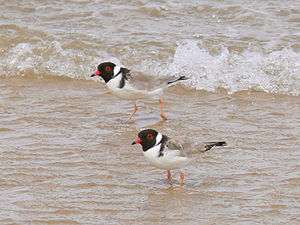Hooded dotterel
| Hooded dotterel | |
|---|---|
 | |
| At Prosser River Spit, Orford, Tasmania, Australia | |
| Scientific classification | |
| Kingdom: | Animalia |
| Phylum: | Chordata |
| Class: | Aves |
| Order: | Charadriiformes |
| Family: | Charadriidae |
| Genus: | Thinornis |
| Species: | T. cucullatus |
| Binomial name | |
| Thinornis cucullatus (Vieillot, 1818) | |
| Synonyms[2] | |
|
Charadrius rubricollis Gmelin, 1789 | |
The hooded plover[3] or hooded dotterel (Thinornis cucullatus) is a species of bird in the family Charadriidae. It is endemic to southern Australia and Tasmania where it inhabits ocean beaches and subcoastal lagoons. There are two recognised subspecies, both of which are classified as endangered.
Taxonomy
The hooded plover was placed in genus Charadrius but in the early 2000s it was reclassified into the genus Thinornis, along with shore plover (Thinornis novaeseelandiae).[4][5] In 2000 the number of mature individuals was estimated at 7,000.[4] Alternate common names include: hooded dotterel, hoody, pluvier à camail (in French), kappenregenpfeifer (in German), and chorlito encapuchado (in Spanish).[5]
Subspecies
Two subspecies of the hooded plover are now recognised.[4]
- T. c. cucullatus (Vieillot, 1818) southern Australia, Queensland, New South Wales, Tasmania and nearby islands. The population stands at 3000 and is declining.[4][6][7]
- T. c. tregellasi (Mathews, 1912)[8] Western Australia, coasts and inland lakes, Cranbrook, Yalgorup National Park and points south.[9][10] The population stands at 4000 and appears to be stable.[4][6][7][8]
Description

The hooded plover is medium in size for a plover, stocky, and pale in colour. Its length is 190 to 230 mm (7.5–9.1 in) and its wing-span 230 to 440 mm (9.1–17.3 in). It has a black hood and throat with a white collar. Its red bill has a black tip. It has a red eye ring and orange legs.[11] Underparts are white. Males and females are similar. Adults and juveniles are similar except the juveniles do not have the black head and hindneck, which are instead a sandy brown.[12]
Behaviour

A clutch of 1–3 eggs is laid from August to March, which includes also the peak of the Austral summer tourist season in its range and it is thereby heavily impacted by human activities.[4][13] The eggs are a matte beige or cream colour heavily sprinkled with dark brown and lavender markings, especially at the larger end of the egg. Pyriform in shape, they measure 37 mm × 27 mm (1.46 in × 1.06 in).[14] Eggs hatch in about 30 days.[14] The eastern population eats a variety of invertebrates but little is known of the diet of the western population.[4][13] Specifically it eats insects, bivalves, and sandhoppers. It is usually seen in pairs or small groups near the water. For breeding it will dig a shallow scrape in sand or gravel above high-water mark and line it with pebbles, seaweed, and other debris.[12]
The population of hooded plovers has declined in eastern Australia as a result of disturbance by people, dogs and horses, as well as predation by silver gulls (Larus novaehollandiae), ravens (Corvus spp) and introduced foxes.[4][13] Fox predation is a major threat to the western subspecies.
Distribution and habitat
Its natural habitats are freshwater lakes, freshwater marshes, coastal saline lagoons, and sandy beaches. Heavy populations are found on beaches with seaweed and dunes. It is threatened by habitat loss because of its small population and limited native range. It is a non-migratory inhabitant of coastal and subcoastal Western Australia, South Australia, New South Wales, Victoria and Tasmania, and is a vagrant in Queensland.
Important Bird Areas
BirdLife International has identified the following sites as being important for hooded plover conservation:[15]
|
|
|
See also
References
- ↑ BirdLife International (2012). "Thinornis rubricollis". IUCN Red List of Threatened Species. Version 2013.2. International Union for Conservation of Nature. Retrieved 26 November 2013.
- ↑ "Thinornis cucullatus". Avibase.
- ↑
- 1 2 3 4 5 6 7 8 "Hooded Plover Thinornis rubricollis". BirdLife International. Retrieved 4 June 2011.
- 1 2 "Hooded Plover (Charadrius rubricollis)". Internet Bird Collection. Retrieved 4 June 2011.
- 1 2 "Taxon Summary – Hooded Plover (western)" (PDF). Department of Sustainability, Environment, Water, Population and Communities. Retrieved 4 June 2011.
- 1 2 "Thinornis rubricollis rubricollis — Hooded Plover". Department of Sustainability, Environment, Water, Population and Communities. Retrieved 4 June 2011.
- 1 2 "Thinornis rubricollis rubricollis — Hooded Plover (eastern)". Department of Sustainability, Environment, Water, Population and Communities. Retrieved 4 June 2011.
- ↑ Elson, Stephen J.; Marcus J. C. Singor (April 2008). "Hooded Plover Thinornis rubricollis tregellasi breeding data from Western Australia" (PDF). Journal for the East Asian – Australasian Flyway. Stilt. 53: 6–12.
- ↑ Singor, Marcus (April 2008). "Inland Movements of the Hooded Plover Thinornis Rubricollis Tregellasi in Western Australia" (PDF). Stilt. Stilt. 55: 25–26.
- ↑ "Hooded Dotterel". Biodiversity Information Explorer. Retrieved 4 June 2011.
- 1 2 "Hooded Plover". Birds in Backyards. Retrieved 4 June 2011.
- 1 2 3 "Thinornis rubricollis". IUCN Red List. IUCN. Retrieved 4 June 2011.
- 1 2 Beruldsen, Gordon (2003). Australian Birds: Their Nests and Eggs. Kenmore Hills, Qld: self. p. 221. ISBN 0-646-42798-9.
- ↑ "Hooded Plover". Important Bird Areas. BirdLife International. 2012. Retrieved 2012-10-27.
External links
| Wikimedia Commons has media related to Thinornis rubricollis. |
-
 Data related to Thinornis rubricollis at Wikispecies
Data related to Thinornis rubricollis at Wikispecies - Hooded plover threats and recovery strategies
